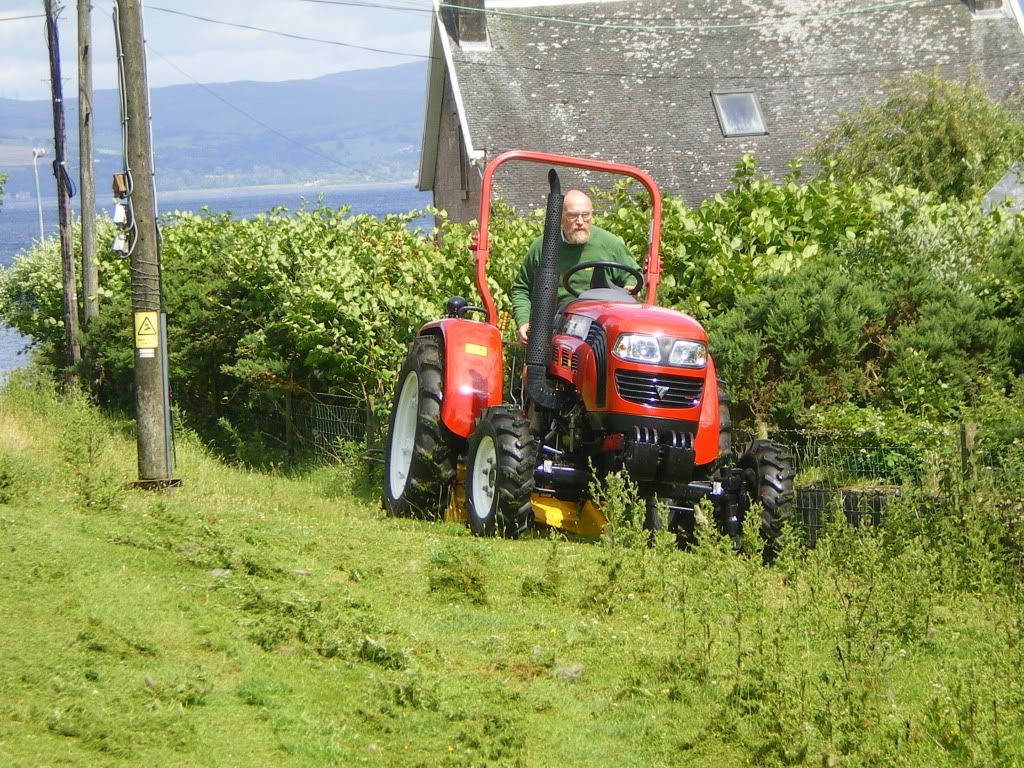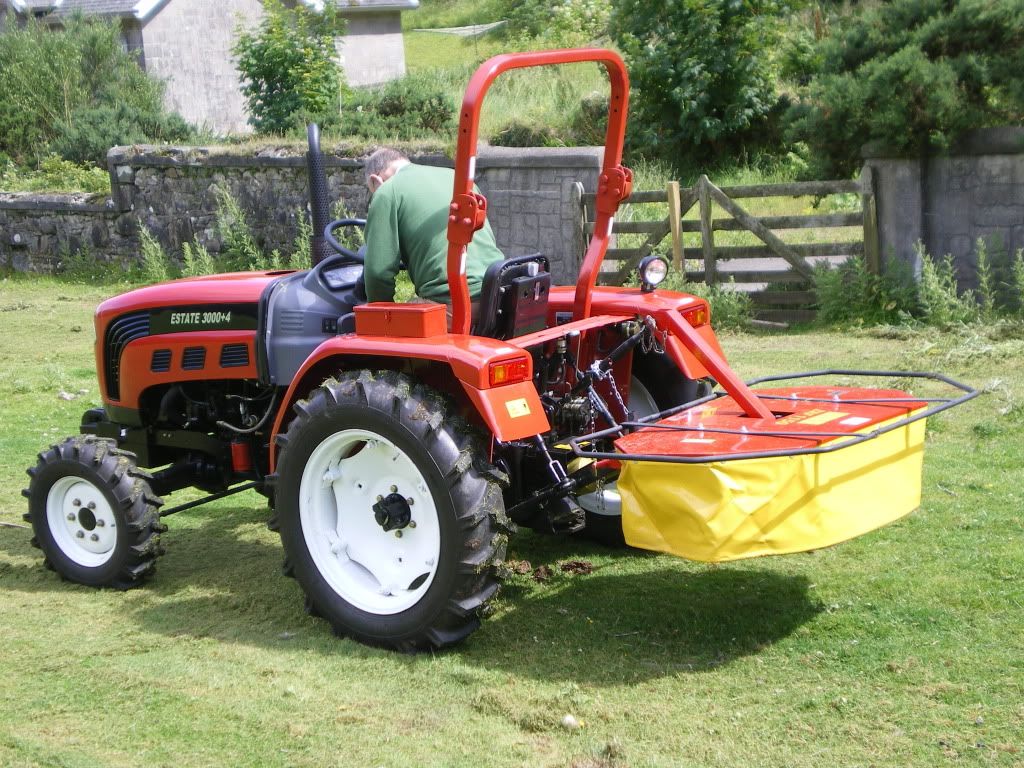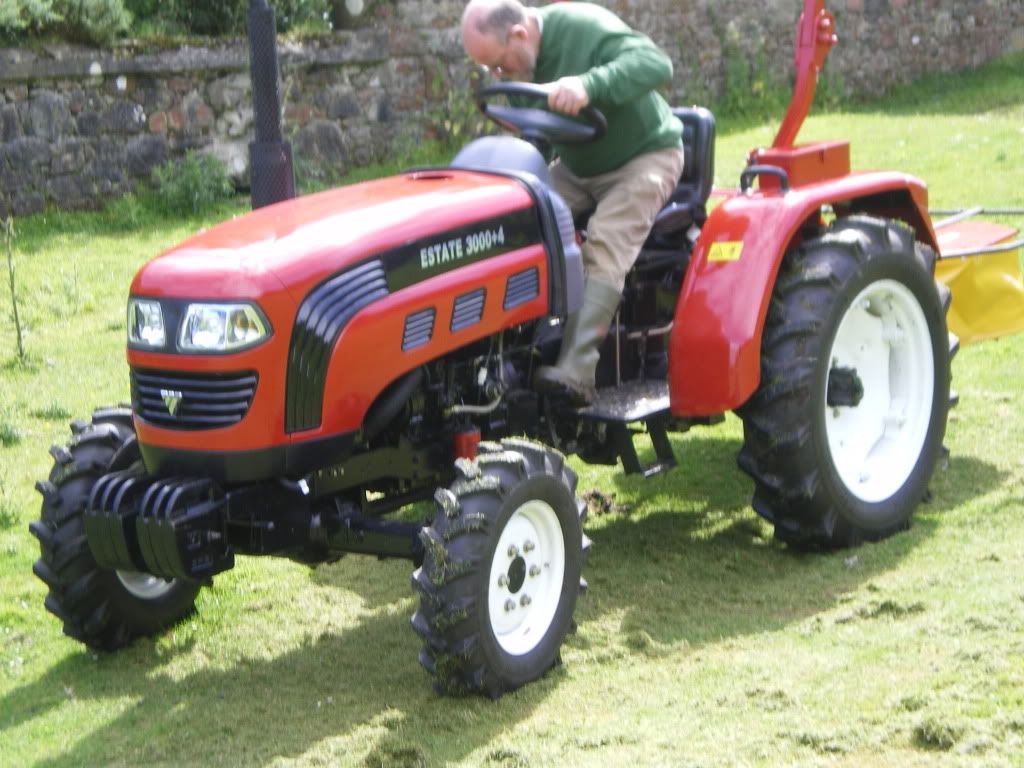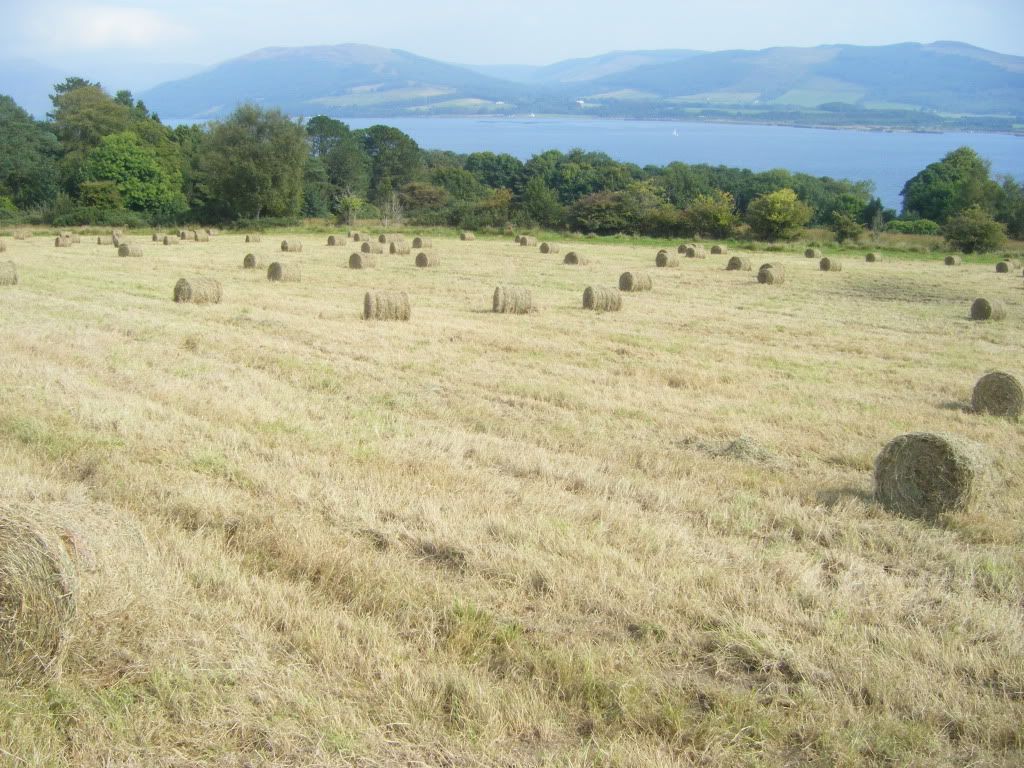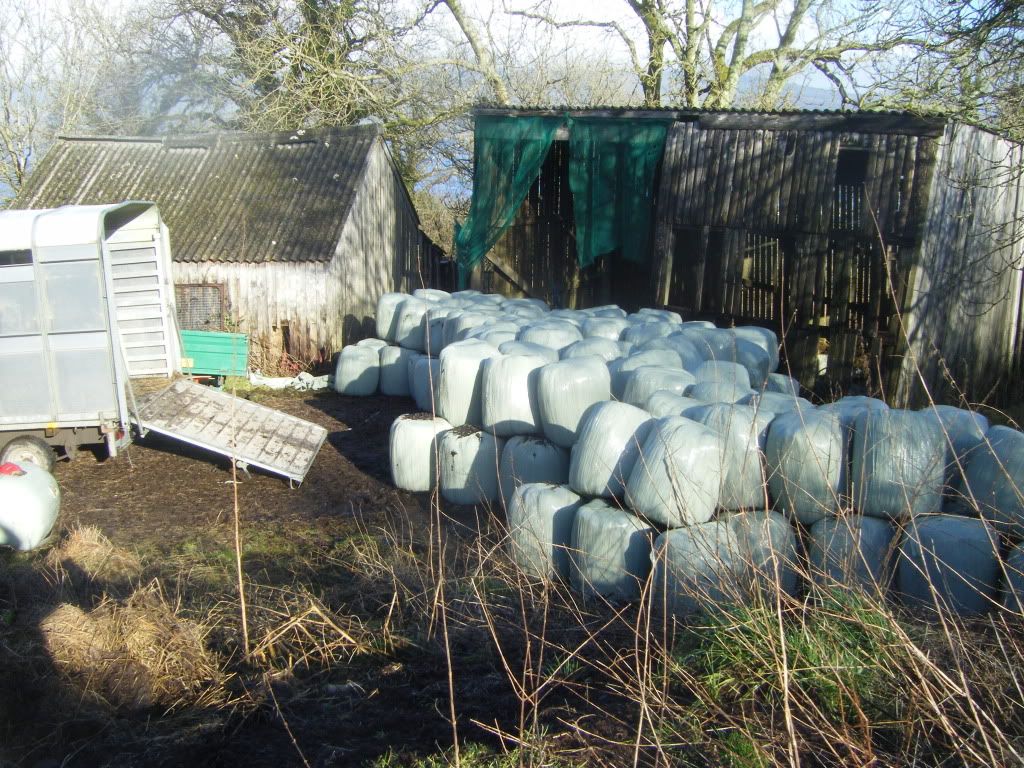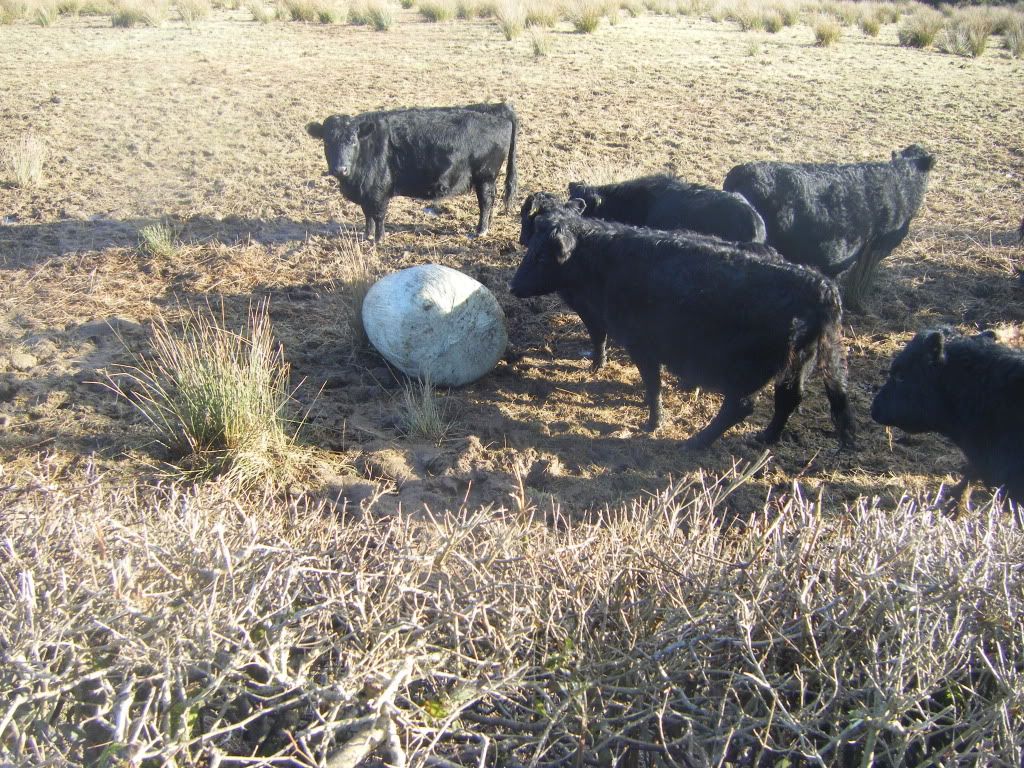Posted: Sat Feb 12, 2011 8:28 pm
In spring of 2010 I decided to equip myself for making small round bales of hay haylage or silage as the cost of buying in hay was so high, and feeding big bales would need big tractors with loader, ring feeders etc etc.
Making my own seemed a much better option than getting contractors to do it as I would be looking at making small quantities in small fields compared to the majority of the farms on Bute.
After looking (a lot) on the internet at compact tractors and equipment, and trying to get prices from Scottish suppliers, I opted to get most of the equipment from Danelander. See http://www.danelanderonline.co.uk . Their website shows most of the stuff I got but not all the exact models. Prices were not too bad, and I got extra stuff or upgraded models instead of discount. The baler cost £4500 when Hamilton Bros were quoting £7500 for a similar machine. To be honest I would have preferred to get locally but they did not seem interested in small stuff. If it had been big farm stuff, OK; or small garden equipment, OK; but small farm stuff just a nuisance.
I bought
Tractor:- Foton 28hp 4WD, has lots of hydraulic take of points, good lift, two ranges of gears, diff lock, standard category 1 three point linkage system. Cost about £5000. I did consider getting a second hand conventional tractor such as old Dexta or MF135 but decided a new machine would be less trouble in the long run and probably better value for money than an old one done up for vintage rallies etc. No regrets so far, done over 100 hours, I have coped with oil and filter changes etc but will get the local garage man (ex MF dealer) to do the first serious servicing. In the middle of this winter's cold spell started literally first time after lying for 1 month.
Mower :- looked at offset mowers but either drum or cutterbar types were all a bit heavy for the tractor on slopes, so went for a 1.1m cut twin drum in line mower. Italian made Zanon make, cost about £1600 which seems a lot compared to second hand old stuff but it has cut about 14 acres, much of it with rush clump stumps left by the big slasher used before we sprayed the rushes last year. It is a very narrow swath but suits the baler. For hay or haylage swaths can be combined when tedding etc. Only bad point is that it leaves a little where the tractor wheel has run over the uncut crop, but it is not a lot and I don't think it is significant.
Star "Gyro-rake" turns, teds, siderakes. Shoould have c cost about £1800 but price and spec altered instead of discount. A well made bit of kit which if anything is a bit heavy for the tractor but does a good job when you get used to it. I only use if I am making haylage or hay - for silage I do not touch the swath before baling. Needs a bit of care when turning and has caused the only breakage of a shear bolt on the lift arm stabilizers.
Baler :- Star Mini Roll Baler - Cost £4500. It has its own wheels but fits on the three point linkage. The PTO shaft is very short and difficult to get connected. It worries me with some of my gateways eg off a road down into the field that I could push the PTO shaft into the back of the tractor, but for normal usage in field it is OK. The bales have Jute twine wrapped round, not net. Totally degradeable. It took a bit of learning how to get best usage out of the baler, with regard to bale density and size. Very easy to make them too heavy to handle. This has to be changed according to wetness of silage, haylage or hay. And remember to change it back again, but not rocket science. The pick up takes most stuff but big clumps of rushes can choke it, and it takes a while getting a choke sorted. The twine can also be a bit tempramental and the threading of it through is a bit complicated but you get used to it. The baler is heavy and on a slope it is easy to have the tractor rear up. I usually try to bale across slopes rather than up and down, as the bales run away if up and down and can unravel the twine and go lose. If they do that it is a dead loss for wrapping.
Wrapper :- Star wrapping machine - On little wheels and handles can be moved about the field or keep at the storage site and wrap there. On the whole easier to take bales unwrapped to storage site and wrap there, but if I am pushed for time I take the machine round the field and wrap them where the baler left them. It then takes a bit more care to get them stacked without damage, but I can manage to do more in a day that way. The machine has its own engine, a "Robin" engine which on closer inspection bears the Subaru logo. Starts very easily. Bales have to be lifted on by hand, and the wrap end tied to a bit of the twine. Maximum wrapping is more expensive but does a better job. I suspect if you sure to use it same season with little transporting the losses from double as opposed to quadruple wrapping are worth taking. Rolls of wrap are 250mm, smaller than the wrap for standard big bales. I did not spend time shopping around for wrap but got a local farmer to get me some when on mainland, probalby paid too much for it. Cost over £1.25 per bale, so in the good weather I would always make hay - but off course that depends on having sheds to store it. Wrapped bales can just stand outside as long as protected from cattle and blowing bushes and hedges. Best stacked on end, they say up to three deep but I have found two deep easy and have had plenty space to do that.
Trailer:- I got a two tone tipping trailer, twin axel job which is small but right for the tractor, and can go behind the landrover too. Not road legal. It takes 7 or 8 bales in a single layer, difficult to stack them high as they are round and bounce or roll off, but as they are only going a short distance best just to take small loads and do it quickly. If I am moving bales on the public road I uses the livestock trailer which avoids the worry of tying them on or having them fall off. I used it in the field for the hay bales to get them in too. But easier to use the wee trailer with the tractor for the silage.
All in all it has been good using the new system, but a bit of a challenge for someone who can remeber the horses leaving the farm when a boy, and the first tractor arriving. The tractor hydraulics, gyro rake, mower, baler and wrapper were all new to me and I found it difficult to get used to it quickly enough. I last made hay in 1968 with a forson Dexta, Ferguson cutterbar mower, Dickie swathturner made for horses and converted to the tractor and an International B45 baler.
I am happy to try to answer any questions anyone has. If you want to see pictures pleas go to my Facebook page, you will find it if you google Burnside Dexter Cattle. I would post pictures here but just can't get photobucket to work easily. If anyone knows how to lift the pictures from Facebook to here I am happy to do that.
All the hay and silage making could not have happened without Steve from Danelander, who has been a great help throughout, delivered it all himself, and has provided advice on phone practically 24/7, with spares, filters shear bolts etc all sent quickly. I would highly recommend Danelander.
I have also had a lot of help from a couple of able bodied assistants with wrapping and stacking, thanks to David McFie and Calum Ferguson. Thanks also to Morton Muirhead on Arran who put the small bale wrapping idea in my head.
Making my own seemed a much better option than getting contractors to do it as I would be looking at making small quantities in small fields compared to the majority of the farms on Bute.
After looking (a lot) on the internet at compact tractors and equipment, and trying to get prices from Scottish suppliers, I opted to get most of the equipment from Danelander. See http://www.danelanderonline.co.uk . Their website shows most of the stuff I got but not all the exact models. Prices were not too bad, and I got extra stuff or upgraded models instead of discount. The baler cost £4500 when Hamilton Bros were quoting £7500 for a similar machine. To be honest I would have preferred to get locally but they did not seem interested in small stuff. If it had been big farm stuff, OK; or small garden equipment, OK; but small farm stuff just a nuisance.
I bought
Tractor:- Foton 28hp 4WD, has lots of hydraulic take of points, good lift, two ranges of gears, diff lock, standard category 1 three point linkage system. Cost about £5000. I did consider getting a second hand conventional tractor such as old Dexta or MF135 but decided a new machine would be less trouble in the long run and probably better value for money than an old one done up for vintage rallies etc. No regrets so far, done over 100 hours, I have coped with oil and filter changes etc but will get the local garage man (ex MF dealer) to do the first serious servicing. In the middle of this winter's cold spell started literally first time after lying for 1 month.
Mower :- looked at offset mowers but either drum or cutterbar types were all a bit heavy for the tractor on slopes, so went for a 1.1m cut twin drum in line mower. Italian made Zanon make, cost about £1600 which seems a lot compared to second hand old stuff but it has cut about 14 acres, much of it with rush clump stumps left by the big slasher used before we sprayed the rushes last year. It is a very narrow swath but suits the baler. For hay or haylage swaths can be combined when tedding etc. Only bad point is that it leaves a little where the tractor wheel has run over the uncut crop, but it is not a lot and I don't think it is significant.
Star "Gyro-rake" turns, teds, siderakes. Shoould have c cost about £1800 but price and spec altered instead of discount. A well made bit of kit which if anything is a bit heavy for the tractor but does a good job when you get used to it. I only use if I am making haylage or hay - for silage I do not touch the swath before baling. Needs a bit of care when turning and has caused the only breakage of a shear bolt on the lift arm stabilizers.
Baler :- Star Mini Roll Baler - Cost £4500. It has its own wheels but fits on the three point linkage. The PTO shaft is very short and difficult to get connected. It worries me with some of my gateways eg off a road down into the field that I could push the PTO shaft into the back of the tractor, but for normal usage in field it is OK. The bales have Jute twine wrapped round, not net. Totally degradeable. It took a bit of learning how to get best usage out of the baler, with regard to bale density and size. Very easy to make them too heavy to handle. This has to be changed according to wetness of silage, haylage or hay. And remember to change it back again, but not rocket science. The pick up takes most stuff but big clumps of rushes can choke it, and it takes a while getting a choke sorted. The twine can also be a bit tempramental and the threading of it through is a bit complicated but you get used to it. The baler is heavy and on a slope it is easy to have the tractor rear up. I usually try to bale across slopes rather than up and down, as the bales run away if up and down and can unravel the twine and go lose. If they do that it is a dead loss for wrapping.
Wrapper :- Star wrapping machine - On little wheels and handles can be moved about the field or keep at the storage site and wrap there. On the whole easier to take bales unwrapped to storage site and wrap there, but if I am pushed for time I take the machine round the field and wrap them where the baler left them. It then takes a bit more care to get them stacked without damage, but I can manage to do more in a day that way. The machine has its own engine, a "Robin" engine which on closer inspection bears the Subaru logo. Starts very easily. Bales have to be lifted on by hand, and the wrap end tied to a bit of the twine. Maximum wrapping is more expensive but does a better job. I suspect if you sure to use it same season with little transporting the losses from double as opposed to quadruple wrapping are worth taking. Rolls of wrap are 250mm, smaller than the wrap for standard big bales. I did not spend time shopping around for wrap but got a local farmer to get me some when on mainland, probalby paid too much for it. Cost over £1.25 per bale, so in the good weather I would always make hay - but off course that depends on having sheds to store it. Wrapped bales can just stand outside as long as protected from cattle and blowing bushes and hedges. Best stacked on end, they say up to three deep but I have found two deep easy and have had plenty space to do that.
Trailer:- I got a two tone tipping trailer, twin axel job which is small but right for the tractor, and can go behind the landrover too. Not road legal. It takes 7 or 8 bales in a single layer, difficult to stack them high as they are round and bounce or roll off, but as they are only going a short distance best just to take small loads and do it quickly. If I am moving bales on the public road I uses the livestock trailer which avoids the worry of tying them on or having them fall off. I used it in the field for the hay bales to get them in too. But easier to use the wee trailer with the tractor for the silage.
All in all it has been good using the new system, but a bit of a challenge for someone who can remeber the horses leaving the farm when a boy, and the first tractor arriving. The tractor hydraulics, gyro rake, mower, baler and wrapper were all new to me and I found it difficult to get used to it quickly enough. I last made hay in 1968 with a forson Dexta, Ferguson cutterbar mower, Dickie swathturner made for horses and converted to the tractor and an International B45 baler.
I am happy to try to answer any questions anyone has. If you want to see pictures pleas go to my Facebook page, you will find it if you google Burnside Dexter Cattle. I would post pictures here but just can't get photobucket to work easily. If anyone knows how to lift the pictures from Facebook to here I am happy to do that.
All the hay and silage making could not have happened without Steve from Danelander, who has been a great help throughout, delivered it all himself, and has provided advice on phone practically 24/7, with spares, filters shear bolts etc all sent quickly. I would highly recommend Danelander.
I have also had a lot of help from a couple of able bodied assistants with wrapping and stacking, thanks to David McFie and Calum Ferguson. Thanks also to Morton Muirhead on Arran who put the small bale wrapping idea in my head.
